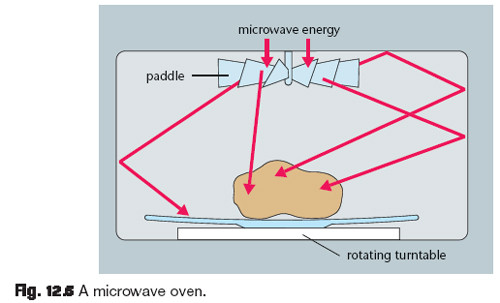The video and text below describes some of the characteristics and uses of Radio waves and Microwaves.
Radio Waves
Radio waves are the lowest-energy, lowest-frequency and longest-wavelength electromagnetic waves. They are produced when an alternating current flows in an aerial and they spread out and travel through the atmosphere. They are not strongly absorbed by the atmosphere. Another aerial is used as a detector and the waves produce an alternating current in it, with a frequency that matches that of the radio waves. Anyone with a receiver can tune it to this frequency to pick up the radio waves so they are suitable for broadcasting (for example, radio and TV programmes) to large numbers of people. An advantage is that this method of communicating does not require wires to transmit information. A disadvantage is that radio stations using similar transmission frequencies sometimes interfere.
A common mistake is to think that we can hear radio waves. We cannot hear any electromagnetic radiation. The radiation is used to carry a signal that is converted into a sound wave by the receiver.
Medium wavelength radio waves are reflected from the ionosphere, a layer of charged particles in the upper atmosphere, so they can be used for long distance communication.
Digital radio has better-quality reception as it uses digital signals and so does not have problems of noise and interference.
Microwaves
Microwaves are sometimes considered to be very short radio waves (highfrequency and high-energy radio waves).
Some important properties of microwaves are:
- They are reflected by metal surfaces.
- They heat materials if they can make atoms or molecules in the material vibrate. The amount of heating depends on the intensity of the microwave radiation, and the time that the material is exposed to the radiation.
- They pass through glass and plastics.
- They pass through the atmosphere.
- They pass through the ionosphere without being reflected.
- They are absorbed by water molecules, how well depends on the frequency (energy) of the microwaves.
- Transmission is affected by wave effects such as reflection, refraction, diffraction and interference.
Microwaves and water molecules
A microwave frequency (energy) can be selected which is strongly absorbed by water molecules, causing them to vibrate, and increasing their kinetic energy. This effect can be used to heat materials containing water, for example food. If the most strongly absorbed frequency (energy) is used in a microwave oven it only cooks the outside of the food because it is all absorbed before it penetrates the food. So the frequency (energy) used in a microwave oven is changed slightly to one that will penetrate about 1cm into the food.
Conduction and convection processes then spread the heat through the food.
As our bodies contain water molecules in our cells, microwave oven radiation will heat up our cells and is very dangerous at high intensity because it will burn body tissue. The radiation is kept inside the oven by the reflecting metal case and metal grid in the door.

Microwaves sent through the atmosphere will be absorbed by water so they can be used to monitor rain. The weaker the signal reaching the detector, the more rain the microwaves have passed through.
Microwave transmissions
Wireless technology uses microwaves and radio waves to transmit information. Advantages are:
- we can receive phone calls and email 24 hours a day
- no wiring is needed to connect laptops to the Internet, or for mobile phones or radio
- communication with wireless technology is portable and convenient.
Microwaves can be used to transmit signals over large distances if there are no obstacles between to reflect or absorb the beam. Another way to say this is that the transmitter and receiver are in line of sight (one can be seen from the other). This is why the transmitters are positioned high up, often on tall microwave masts. They cannot be spaced so far apart that, for example, hills or the curvature of the Earth stop the beam.
Microwaves are used to send signals to and from satellites. The satellites can relay signals around the Earth. Microwaves are used because they pass through the atmosphere and through the ionosphere. The signals may be for television programmes, telephone conversations, or monitoring the Earth (for example, weather forecasting).
When microwaves are transmitted from a dish the wavelength must be small compared to the dish diameter to reduce diffraction – the spreading out of the beam. The dish is made of metal because metal reflects microwaves well.
Mobile phones use microwave signals. The signals from the transmitting phones reflect off metal surfaces and walls to communicate with the nearest transmitter mast. There is a network of transmitter masts to relay the signals on to the nearest mast to the receiving phone.
Mobile phones have not been in widespread use for many years, so there is not much data about the possible dangers of using them. The transmitter is held close to the user’s head so the microwaves must have a small heating effect on the brain. There are questions about whether this could be dangerous, or whether it is not large enough to be a problem. So far studies have not found that users have suffered any serious ill effects. There may also be a risk to residents living close to mobile phone masts.
Low-intensity microwave radiation, from mobile phone masts and handsets, may be a health risk, but there is disagreement about this.
